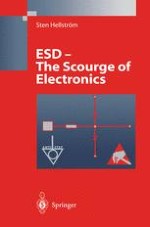1998 | OriginalPaper | Chapter
Protection methods — Antistatic materials
Author : Dr. Sten Hellström
Published in: ESD — The Scourge of Electronics
Publisher: Springer Berlin Heidelberg
Included in: Professional Book Archive
Activate our intelligent search to find suitable subject content or patents.
Select sections of text to find matching patents with Artificial Intelligence. powered by
Select sections of text to find additional relevant content using AI-assisted search. powered by
In the sixties MOS-components were regarded as very ESD-sensitive. But when new component technologies were introduced, especially IC:s, it was realised that other circuit elements could be sensitive to ESD. The narrow conductors, the small distances between circuits and the thin oxide layers increase the sensitivity. Now all kind of electronic components even passive, are considered sensitive to ESD. This has started activities to avoid or preferable eliminate ESD hazards. A general measure in that direction is to increase the relative humidity (RH-value). By that otherwise insulating surfaces are rendered slightly conductive, thus counteracting charge formation. Alternatively ionizers can be used producing ions that neutralize charge of opposite sign, a method often used in clean rooms. The aim is to create an ESD-safe environment. But these actions are often not enough. This chapter will describe all protection methods. Another early measure was to supply electronic circuits with special protection circuits, incorporated in the circuitry. The function of them is to reduce voltage and currents of transients to a harmless level and dissipate energy developed by them.
